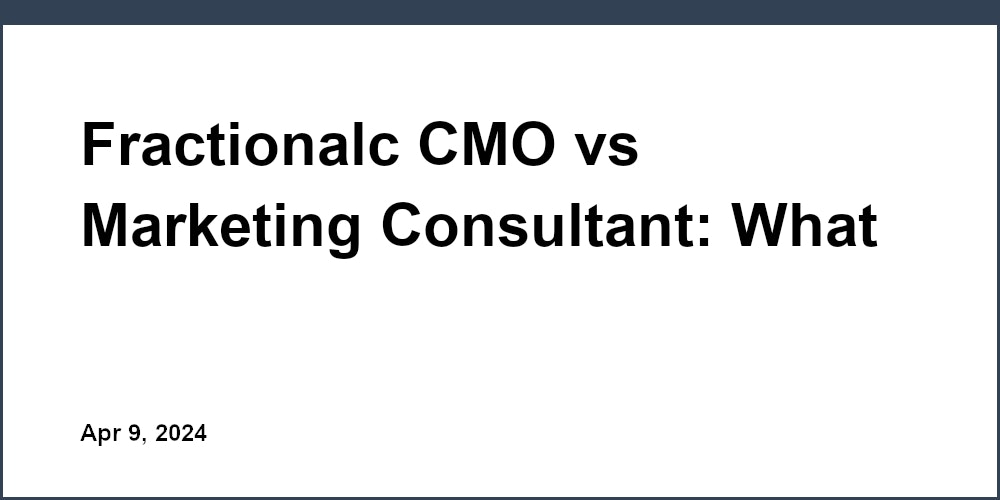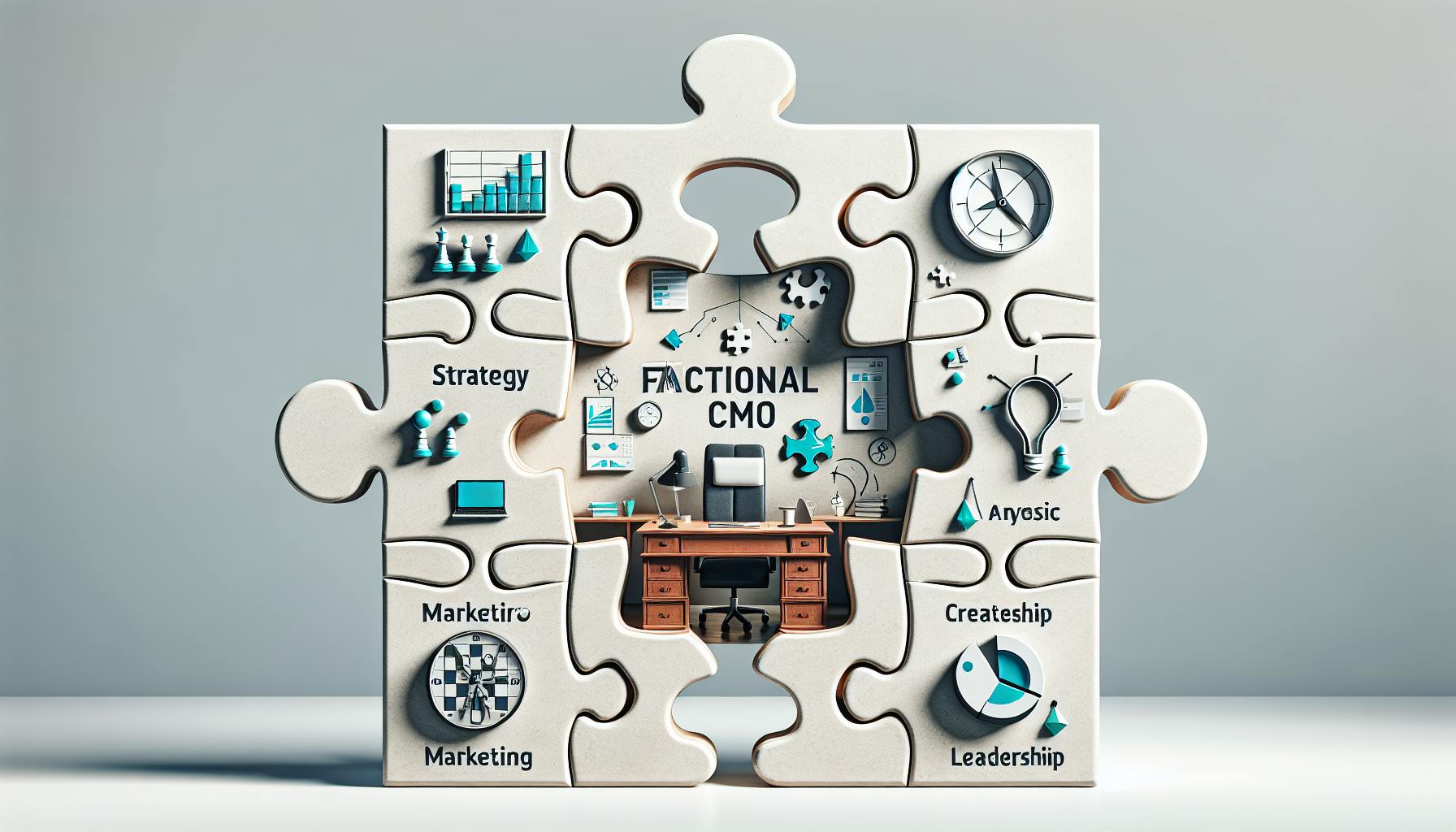In today’s competitive business environment, achieving marketing success is no longer about simply following trends or adopting a "one-size-fits-all" approach. For startup founders, SME owners, and business leaders, navigating the complexities of modern marketing while also scaling their businesses can feel overwhelming. Enter the fractional Chief Marketing Officer (CMO) model - a transformative solution redefining how businesses harness marketing expertise.
Based on insights shared from a discussion with marketing expert Tre Redfern, this article dissects how fractional CMOs bridge critical gaps in marketing strategy, offering businesses tailored, high-impact solutions. From addressing overlooked inefficiencies to leveraging the latest in AI, here’s how fractional CMOs are reshaping the growth landscape for businesses.
The Rise of the Fractional CMO: Filling a Critical Void
Marketing challenges for businesses often fall into two distinct approaches: relying on internal staff ("butts in seats") or hiring external agencies. While both options have their merits, they also come with limitations.
- Internal Staff: Employees may understand how to execute specific tasks but lack the strategic insight to optimize campaigns or align them with long-term business goals.
- Agencies: Agencies often come with pre-packaged methodologies and playbooks, which can deliver results but may lack the flexibility or transparency that businesses need.
This is where the fractional CMO comes into play. Fractional CMOs act as a bridge between these two extremes, offering high-level strategic expertise while working in tandem with existing resources or external partners. They provide businesses with:
- Strategic oversight to focus on long-term goals rather than fleeting trends.
- Accountability for both internal teams and external agencies.
- Tailored marketing plans that identify and optimize what’s working while eliminating inefficiencies.
Key Differentiator: Strategic Leadership
Unlike traditional marketing hires, fractional CMOs bring years of experience and an outside perspective to help businesses make data-driven decisions. They guide companies toward sustainable growth by focusing on measurable KPIs, eliminating waste, and aligning marketing initiatives with broader business objectives.
Who Needs a Fractional CMO?
The ideal clients for fractional CMOs are businesses that have grown beyond the startup phase but lack the internal marketing leadership to scale effectively. Tre Redfern highlights that most companies benefitting from this model fall within the $1 million to $20 million annual revenue range. However, businesses earning as low as $500,000 but aiming for aggressive growth can also benefit.
Industries such as professional services (lawyers, doctors, accountants, financial advisors) often see significant results from fractional CMOs. These businesses frequently face unique marketing challenges, like compliance in advertising or identifying niche target markets, which require specialized expertise.
The Process: How Fractional CMOs Deliver Results
One of the hallmarks of fractional CMOs is their systematic approach to diagnosing and solving marketing problems. Redfern’s team begins each engagement with a comprehensive marketing audit.
The Audit: A Critical First Step
This deep dive covers multiple elements of a business’s marketing operations, including:
- Search Engine Marketing (SEM) and Optimization (SEO): Ensuring businesses rank high organically and through paid efforts.
- Website Analysis: A 71-point checklist reviews functionality, mobile optimization, and user experience.
- Email Marketing: Evaluating deliverability and nurturing campaign effectiveness.
- Paid Ads and Budgeting: Identifying wasted ad spend and optimizing ROI.
The audit often uncovers hidden inefficiencies, such as incorrect tracking, outdated strategies, or even glaring errors like broken customer funnels. For example, Redfern shared a case where a plastic surgeon’s mobile site mistakenly displayed a competitor’s phone number, costing them hundreds of thousands in lost revenue.
Optimization and Accountability
Once problem areas are identified, fractional CMOs implement custom solutions designed to maximize ROI. Their ongoing role includes:
- Regularly tracking KPIs to measure progress.
- Ensuring marketing initiatives align with the business’s overall strategy.
- Providing hands-on strategic guidance while empowering internal teams to execute effectively.
Success Stories: Real-World Transformations
To understand the tangible impact of fractional CMOs, consider two examples shared by Redfern:
- CPG Company Saves $35,000 in a Quarter: A consumer product company discovered their agency was overcharging them by 7.5% more than the agreed-upon rate. By identifying this discrepancy during the audit, they saved $35,000 in a single quarter - more than covering the cost of the fractional CMO’s services.
- Plastic Surgeon Rescues Mobile Leads: The aforementioned case of a plastic surgeon serves as a stark reminder of how even small errors can lead to significant losses. Fixing such a fundamental issue allowed the clinic to stop hemorrhaging leads and refocus marketing efforts on driving growth.
These examples highlight the high ROI potential of partnering with a fractional CMO, as well as their ability to identify and resolve issues that frequently go unnoticed.
Staying Ahead: Leveraging AI and Innovation
The marketing landscape evolves at a breakneck pace, with AI emerging as a transformative force. According to Redfern, while AI tools are becoming ubiquitous, understanding how to use them effectively is a differentiator for businesses.
How Fractional CMOs Use AI
- Content Creation: AI tools assist in generating targeted, high-quality copy, saving time while maintaining consistency.
- Hyper-Personalization: Businesses can create thousands of personalized emails or videos at scale to enhance customer engagement.
- Efficiency in Analysis: AI enables rapid analysis of marketing data, allowing companies to identify trends and opportunities quicker than ever before.
Redfern’s team encourages experimentation with AI by allocating time for employees to explore new tools and report back on what works. This proactive approach ensures they stay ahead of industry trends and deliver cutting-edge strategies to their clients.
Challenges and Opportunities
For entrepreneurs like Tre Redfern, one of the biggest challenges is balancing passion with scalability. While working directly with clients remains one of the most rewarding aspects of his job, scaling requires delegation and trust in a team of equally skilled experts.
Despite these challenges, the satisfaction of making small, strategic changes that result in massive business transformations keeps the passion alive. As Redfern puts it, "Small hinges swing big doors."
Key Takeaways
- Fractional CMOs bridge the gap between in-house talent and external agencies, offering strategic leadership that drives sustainable growth.
- Start with a marketing audit to identify inefficiencies, eliminate waste, and optimize what’s working.
- Ideal candidates for fractional CMOs are businesses earning $1 million to $20 million annually, although smaller companies with growth ambitions can also benefit.
- AI is becoming integral to marketing success, enabling businesses to personalize at scale and analyze data more effectively.
- Real-world examples show the ROI: Whether uncovering hidden costs or fixing critical errors, fractional CMOs can deliver immediate and lasting value.
- Building internal expertise is key: Companies benefit most when fractional CMOs work alongside their teams to implement sustainable strategies.
Conclusion
For businesses navigating the complexities of modern marketing, a fractional CMO provides the perfect blend of strategy, expertise, and flexibility. By focusing on high-impact, data-driven solutions, these professionals empower companies to grow, innovate, and compete in an ever-changing marketplace.
Whether you’re a startup founder looking to scale or an SME owner struggling with inefficiencies, the expertise of a fractional CMO could be the transformational element your business needs. As this model continues to gain traction, it’s clear that fractional CMOs are not just a trend - they’re the future of strategic marketing.
Source: "Episode 1174: Navigating Growth with a Fractional CMO Model" - SharkPreneur: Seth Greene and Kevin Harrington, YouTube, Aug 18, 2025 - https://www.youtube.com/watch?v=GkxLn2bDBzM
Use: Embedded for reference. Brief quotes used for commentary/review.



